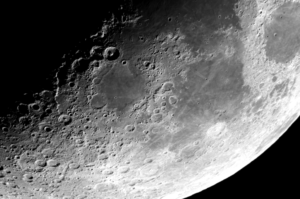Luna
"Which is the more useful, the Sun or Moon??...
Of course, the Moon!
It gives us light at night whereas the Sun is needless because the day is already bright."
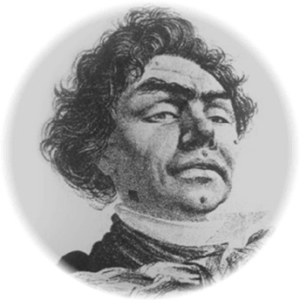
Kozma Prutkov
Fictitious Philosopher
Public Domain,
Wikimedia Commons
"Which is the more useful, the Sun or Moon??...
Of course, the Moon!
It gives us light at night whereas the Sun shines needlessly in the daytime which is already bright."

Kozma Prutkov
Tolstoy’s Fictitious Philosopher
Public Domain,
Wikimedia Commons
Stony Ridge and "Moon Shots"
Lunar Photography - it's in Our DNA
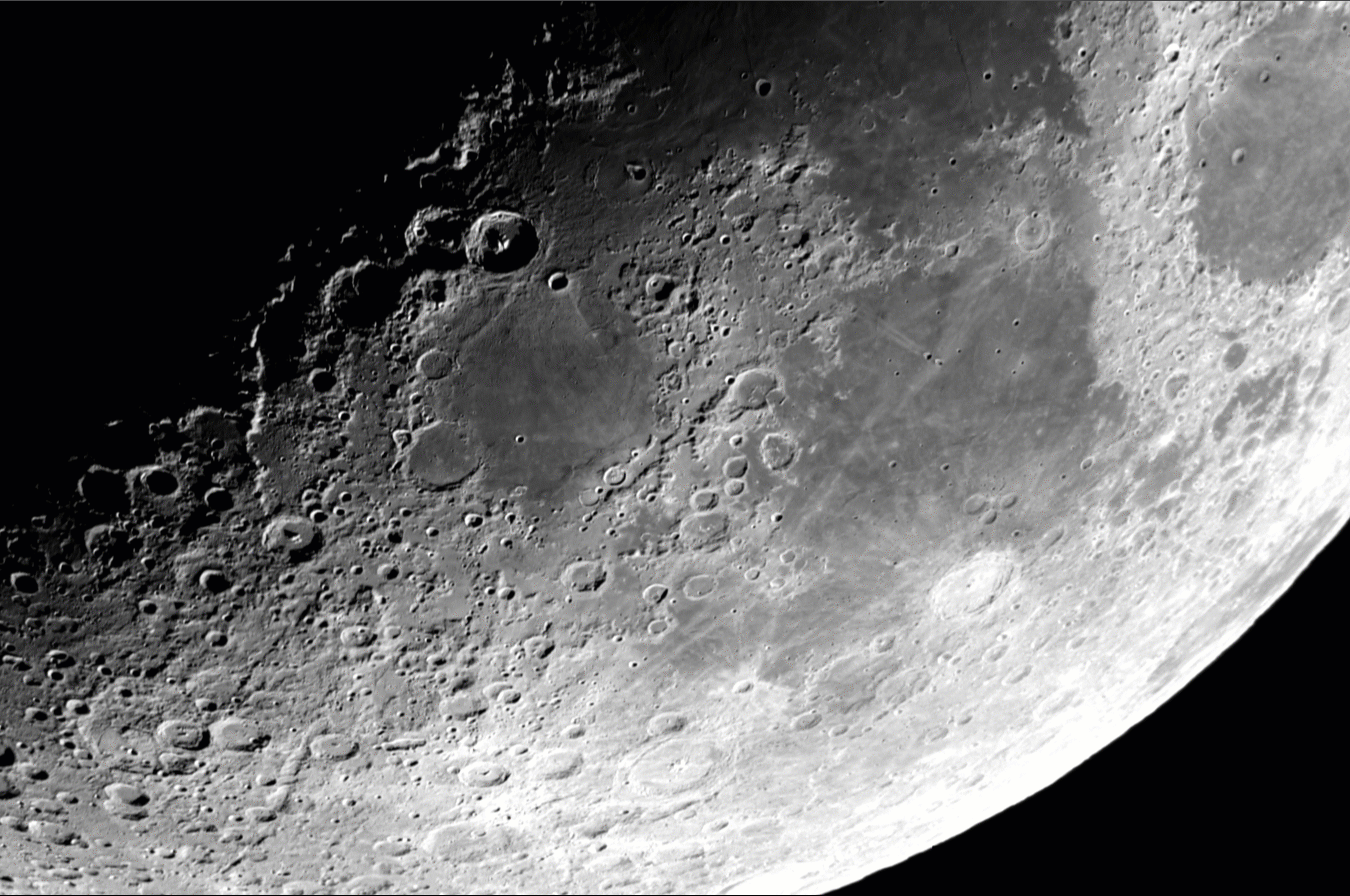
"Six Day Old" Moon
Candace Dougherty
In this superb image, from November 2nd, 2019, relief effects along the terminator are evident as the rising Sun's low angle rays accentuate even the smallest deviations from flat terrain. Further east (to the right) where the solar disk would appear higher, shadows are minimal and changes in elevation are much harder to detect.
Lunar nomenclature consists of both honorific recognition and that which is merely descriptive. Names need not be related to persons or topics of astronomy or space sciences, though many are. The image shown here has been augmented to show a few craters that do have astronomical ties, from right to left:
"Yerkes," named after Chicago investor and street car magnate Charles T. Yerkes who allocated funds to build the 40-inch refractor and observatory at Williams Bay, Wisconsin
"Lick," for James Lick, real-estate tycoon and philanthropist who became the benefactor and namesake of the facility on Mt. Hamilton, California
"Messier," for the French astronomer and comet hunter Charles Messier who set out to catalog objects that would not be further mistaken for comets, his primary research interest. He ended up compiling a famous list of some of the "best and brightest" deep-sky objects. (Ironically, Messier's name does not appear on the "guest list" posted outside the entrance to Père Lachaise cemetery in Paris where he is interred along with the likes of luminaries like Oscar Wilde, Chopin, and Jim Morrison!)
"Capella," - for the brightest star in the constellation Auriga, the Charioteer
"Mädler," - for German astronomer Johann Heinrich von Mädler who made contributions to Martian and Lunar cartography
"Rosse," - after William Parsons, the Third Earl of Rosse and developer of the "Leviathan of Parsonstown," a huge, 72-inch "speculum metal" reflecting telescope at Birr Castle, Ireland
Also identified is the crater McClure whose name is familiar in the history of SRO. Alas, though Alan's contributions to comet photography were both exquisite and significant, this feature is not a remembrance of him but perhaps another in his "clan," in this case British explorer Robert McClure.

"Six Day Old" Moon
Candace Dougherty
In this superb image, from November 2nd, 2019, relief effects along the terminator are evident as the rising Sun's low angle rays accentuate even the smallest deviations from flat terrain. Further east (to the right) where the solar disk would appear higher, shadows are minimal and changes in elevation are much harder to detect.
Lunar nomenclature consists of both honorific recognition and that which is merely descriptive. Names need not be related to persons or topics of astronomy or space sciences, though many are. The image shown here has been augmented to show a few craters that do have astronomical ties, from right to left:
"Yerkes," named after Chicago investor and street car magnate Charles T. Yerkes who allocated funds to build the 40-inch refractor and observatory at Williams Bay, Wisconsin
"Lick," for James Lick, real-estate tycoon and philanthropist who became the benefactor and namesake of the facility on Mt. Hamilton, California
"Messier," for the French astronomer and comet hunter Charles Messier who set out to catalog objects that would not be further mistaken for comets, his primary research interest. He ended up compiling a famous list of some of the "best and brightest" deep-sky objects. (Ironically, Messier's name does not appear on the "guest list" posted outside the entrance to Père Lachaise cemetery in Paris where he is interred along with the likes of luminaries like Oscar Wilde, Chopin, and Jim Morrison!)
"Capella," - for the brightest star in the constellation Auriga, the Charioteer
"Mädler," - for German astronomer Johann Heinrich von Mädler who made contributions to Martian and Lunar cartography
"Rosse," - after William Parsons, the Third Earl of Rosse and developer of the "Leviathan of Parsonstown," a huge, 72-inch "speculum metal" reflecting telescope at Birr Castle, Ireland
Also identified is the crater McClure whose name is familiar in the history of SRO. Alas, though Alan's contributions to comet photography were both exquisite and significant, this feature is not a remembrance of him but perhaps another in his "clan," in this case British explorer Robert McClure.
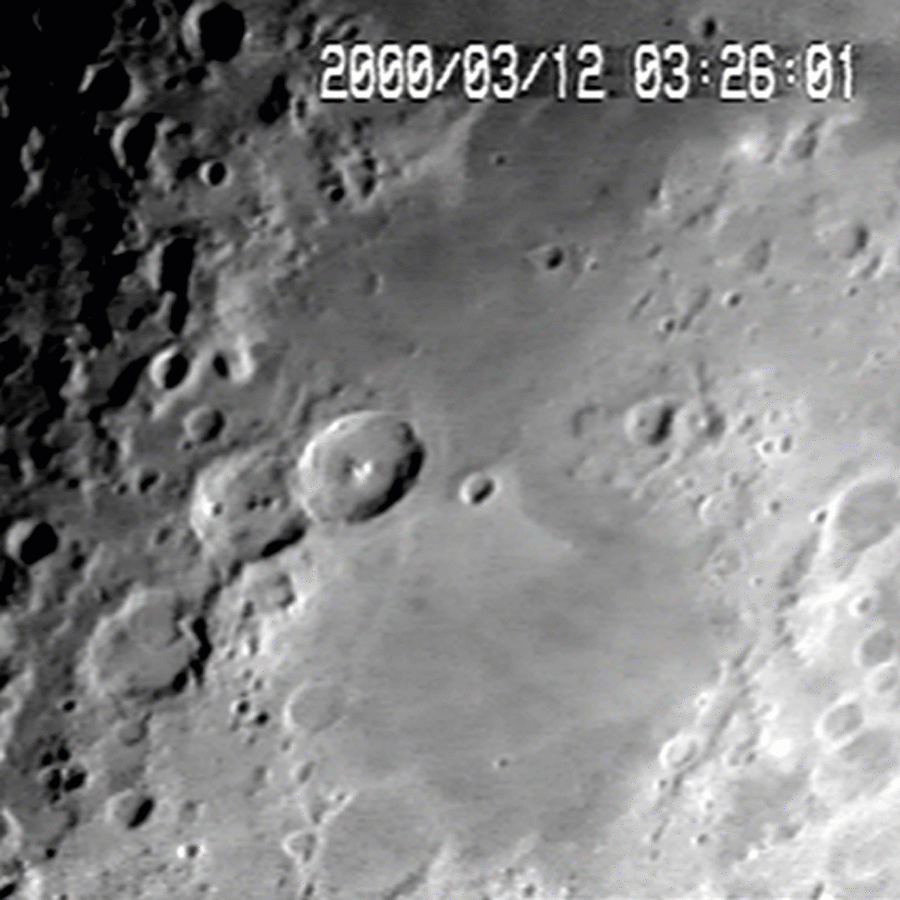
Moon Mosaic
Steve Brewster
High resolution photography of extended objects like the Moon has become easier in the modern era as a result of advances in digital electronics, optics, and software. But these technologies were either not available or at least in their relative infancy when this mosaic was assembled from frames of video caputured in March of 2000.
A seamless stitching would be practically impossible because of issues like exposure balancing and geometric distortion in the image plane. The time stamps would also have to be eliminated by attempting to overlay them with data from an adjacent frame. From start to finish, this technique would have been a daunting task to be sure.
Nevertheless, Brewster set out to leverage the resolving power of the Carroll telescope and overcome the relative narrow field of view in his setup to create this fully constructed view with all pieces in place. The results speak for themselves and artfully show that astrophotography is sometimes a delicate dance between aethstetic and science.

Moon Mosaic
Steve Brewster
High resolution photography of extended objects like the Moon has become easier in the modern era as a result of advances in digital electronics, optics, and software. But these technologies were either not available or at least in their relative infancy when this mosaic was assembled from frames of video caputured in March of 2000.
A seamless stitching would be practically impossible because of issues like exposure balancing and geometric distortion in the image plane. The time stamps would also have to be eliminated by attempting to overlay them with data from an adjacent frame. From start to finish, this technique would have been a daunting task to be sure.
Nevertheless, Brewster set out to leverage the resolving power of the Carroll telescope and overcome the relative narrow field of view in his setup to create this fully constructed view with all pieces in place. The results speak for themselves and artfully show that astrophotography is sometimes a delicate dance between aethstetic and science.
Eclipses: Astronomical Sunblock?!
Lunar Eclipses
A lunar eclipse offers the chance to see the “Full” moon bathed in copperish light and while not a frequent event, it cannot be described as rare. During the eclipse, anyone who can see the moon will witness essentially the same thing regardless of how much sunlight is impeded by Earth.
The circumstances for creating a lunar eclipse occur when the Moon passes through some part of the shadow that Earth is always casting.
It may be easiest to understand what is happening if you imagine yourself on the Moon and looking toward the Earth as it passes in front of the solar disk. From that vantage point, if any part of the Sun is blocked, you are in a partially shadowed region called the penumbra. If the Sun is fully blocked, you are in maximum shadow – the umbra. In the animation below, we see the projection of these shadows onto the Moon as it moves through those darkened areas.
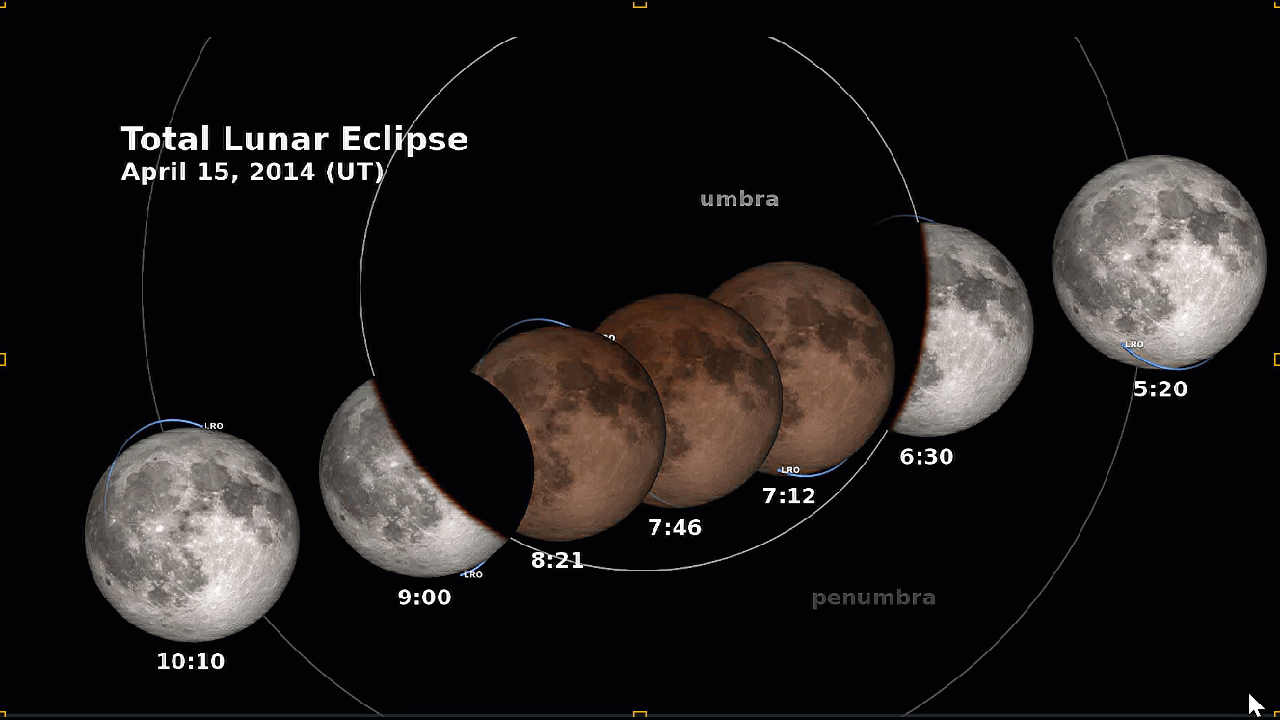

NASA, Public Domain
Within the umbra, no part of the Sun’s disk is visible, but the area isn’t completely dark because some sunlight is still able to refract through our atmosphere and continue moonward. This faint light is reddish because the blue and green components disperse leaving only a ruddy, coppery red.
Lunar eclipses are relatively easy to image with a camera and, ideally, a telephoto lens although telescopes can certainly be employed.
Solar Eclipses
A total solar eclipse is considered a precious opportunity based on the very narrow range of locations which will see the moon pass directly in front of the Sun’s disk and at the a favorable Earth-Moon distance, a dimension which changes since planetary bodies travel in elliptical orbits.
If the Moon’s apparent diameter is less than that of the Sun, an annular eclipse is seen, one in which a ring of bright light encircles the lunar disk.
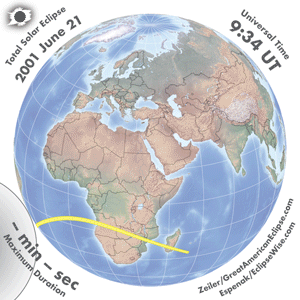
In the Shadow of the Moon
This animation, created for a vantage point on the Moon, has much to offer when trying to visualize the circumstances of a total solar eclipse.
Observers anywhere inside the wide black circle (but outside the small black dot) will see some portion of the Sun blocked by the Moon. For them, the eclispe is partial. But within that dot is Totality - total obscuration.
Notice that the duration of Totality varies and is greatest for observers whose position on the Earth (a three dimensional object!) is closest to the Moon and thus, more deeply projected into the cone of the shadow.
Interesting Fact: a Totality like the one illustrated here is occuring someplace in space on a continuous basis with just one exception - during a lunar eclipse! Do you see why that is??

In the Shadow of the Moon
This animation, created for a vantage point on the Moon, has much to offer when trying to visualize the circumstances of a total solar eclipse.
Observers anywhere inside the wide black circle (but outside the small black dot) will see some portion of the Sun blocked by the Moon. For them, the eclispe is partial. But within that dot is Totality - total obscuration.
Notice that the duration of Totality varies and is greatest for observers whose position on the Earth (a three dimensional object!) is closest to the Moon and thus, more deeply projected into the cone of the shadow.
Interesting Fact: a Totality like the one illustrated here is occuring someplace in space on a continuous basis with just one exception - during a lunar eclipse! Do you see why that is??
Michael Zeiler, CC BY-SA 4.0
via Wikimedia Commons
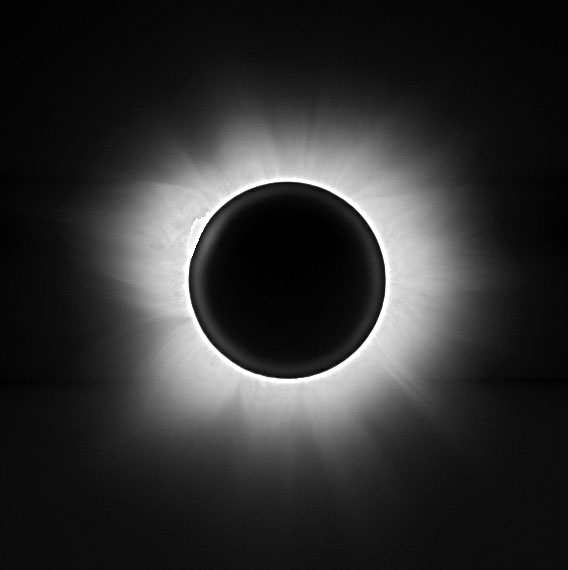

NASA – Williams College Expedition,
Public Domain,
via Wikimedia Commons
Eye protection is essential when viewing any solar eclipse. It must be properly designed, properly constructed, and properly used to provide the necessary protections!
Even though it is safe to view with the naked eye so long as no part of the Sun’s disk is seen (i.e., the condition called “Totality”), observers must be prepared for the transitions in and out of Totality. Even a very brief exposure to any part of the Sun’s disk can lead to permanent eye damage.
Observers off the narrow groundtrack denoting Totality will see a partial eclipse; those lying within that path will experience a longer Totality the nearer they are to the exact center of that corridor.
Photography of solar eclipses requires great care in the setup and use of equipment and is certainly more difficult than lunar eclipse photography!
Lunar E"motions"??
More of the Moon to Love!
What percentage of the Moon’s surface can be seen from Earth? Would you guess half – 50%?? After all, the same features seem to face us no matter when you look!
Actually, it’s more than half…around 59%, give or take.
The reasons for this are deeply rooted in gravitational complexities within the Earth-Moon system, a “laboratory” where the Sun also plays a major role and no body can be treated as a point mass acting at its center. Bulges in the non-spherical Earth and Moon and ocean tides are major complicating factors. (Issac Newton once confessed to Edmund Halley that quantifying Lunar motion made his head hurt. Really!)
Libration - the Moon Shakes it Head and Says "No"
Part of the explanation owes to the properties of the Moon’s elliptical orbit according to Kepler’s Laws. The result, called Libration, allows us to sometimes see parts of the Moon’s surface further east or further west of the areas always in view.
Nutation - the Moon Nods "Yes"
Nutation on the other hand produces a “nodding” effect in which we can sometimes see beyond the Moon’s north and south poles.
As you might imagine, photography of these fringe regions which offer little more than a low, glancing perspective, is challenging even under the best of circumstances!








